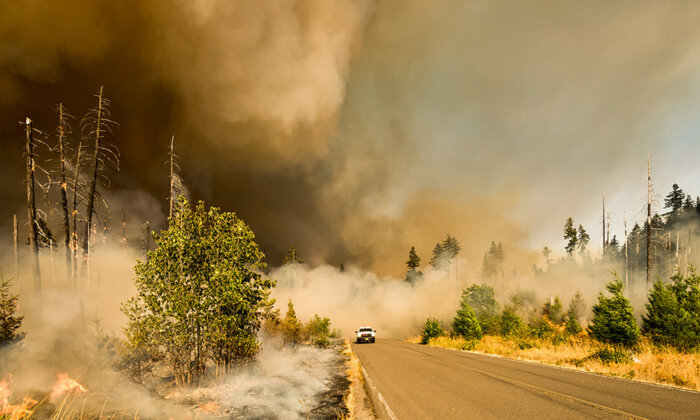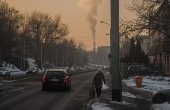Do Extreme Weather Events Change Climate Policy?

Global Environmental Politics (GEP) began last year celebrating 20 years of publication. Yet, by March, it had become clear that 2020 was a year like no other. We were not just in the midst of a climate crisis, with fires in Australia and the Amazon and flooding in Indonesia serving as a harbinger for a year of horrendous climate catastrophes, but a global pandemic — the likes of which had not been seen since the influenza pandemic of 1919 — confronted the entire global community.
Thus, Issue 21-1 of GEP, published this month, includes a special section on “The Politics of Crises and Disasters” wherein scholars examine an array of disasters and crises to inform and provoke academic and policy debates as we seek to make sense of this new “normal.” In his research article, “Silver Lining to Extreme Weather Events? Democracy and Climate Change Mitigation,” Lauri Peterson, a political scientist who works on issues related to climate policy, comparative politics, and climate financing, offers a reason for hope in the aftermath of climate disasters.
Through an impressive cross-national analysis, Peterson finds little evidence for a general trend of enhanced climate policies post-disaster, but rather he finds that highly functioning democracies are spurred to greater climate ambition after facing extreme weather events. Peterson’s findings, which he explores in the interview that follows, not only contribute to our understanding of the policy implications of external shocks, but also speak to the ongoing conversation about the role of democracy in responding to the climate crisis.
The Editors: You wrote about what seems to be a very important finding (that extreme weather events propel only highly functioning democracies to tackle climate change). How did your research approach this question? What method did you use to explore it?
Lauri Peterson: There is an ongoing debate in academia and the media about the role of extreme weather events and democracy in shaping policy responses to climate change. However, when I started to work on this study, I found there is not much research studying the impact of these events on climate policy and even less looking into how democratic and non-democratic countries respond to climate-related disasters differently.
I realized that in order to compare their climate policies, I would need to study a larger sample of countries over a period of time rather than looking at just a few key countries. So I used statistical methods, which are appropriate for quantitative time-series data, on national climate policy from 2008 to 2017. The focus was on extreme weather events, such as floods, storms, and wildfires, which are most commonly associated with climate change in both research and the media. I tested the effect of extreme weather events on climate policy over time and found that the effect appears to be short-lived. I also checked whether it matters if democracy is conceptualized as a scale (more democratic to less democratic) or as a dichotomy (democracies vs. non-democracies). In both cases, solid democracies — that is, highly democratic countries — were more likely to increase their ambition to tackle climate change after the occurrence of extreme weather events.
The Editors: Which countries did you address in your research? How did you define the levels of “democracies”?
LP: The study included 58 countries in total. This includes most of the so-called high-income countries (as they are called by the World Bank), such as states in the EU and North America, but also middle-income countries, such as Argentina, China, India, Iran, and South Africa. This gives the study a good overview of countries with different regime types and climate impacts.
In order to place countries on a scale, where you have highly democratic countries on the one end and less democratic regimes on the other end, I drew upon established global indices of democracy, such as University of Gothenburg’s Varieties of Democracies (V-Dem) Electoral Democracy Index. This particular measure ranks countries based on surveys of 3,000 “Country Experts” who take into account fundamental democratic values, such as freedom of association, fair elections, freedom of expression, alternative sources of information, elected officials, and suffrage. I think we can agree that these are the basic ingredients of any democracy.
“Belief in climate change and climate action in the United States may not be as low as people think.”
However, I also tested whether it matters if instead of a scale we separate countries into clear-cut categories of democracies and non-democracies. For that, I relied on the Polity data-series by the Center for Systemic Peace. I used Polity to order countries into categories of democratic and non-democratic political regimes, a very common measure of democracy within this field of research.
The Editors: How can you categorize the democratic level of countries such as the United States that flipflop back and forth between more and less democratic fairly frequently, depending upon who is in power at the moment?
LP: It is true that there have been some signs of democratic backsliding in the United States and the V-Dem Electoral Democracy Index appears to capture that as well. Nevertheless, the U.S. is a solid democratic country with strong institutions. This is especially the case if you put the U.S. in a global comparison. I think the current transition to President Biden’s administration reflects that reality.
I would also point out that belief in climate change and climate action in the United States may not be as low as people think. The Yale Program on Climate Change Communication shows in their recent report “Climate Change in the American Mind” that 72 percent of Americans believe global warming is taking place and more than two-thirds say that the country should reach 100 percent clean power by 2035. Pew’s research on public opinion shows similar trends about climate policies. Climate change is an extremely partisan topic in the U.S., but most Americans agree with the idea that more needs to be done in order to tackle climate change and minimize its effects.
The Editors: How did you go about evaluating and comparing the countries’ efforts to combat climate change?
LP: I needed a measure that accounts for climate ambition that aggregates different types of climate mitigation policies and compares them in many countries across time. I considered several different measures but eventually decided to use the national climate policy sub-indicator of the Climate Change Performance Index, which was developed by the NGO GermanWatch. The indicator is based on annual surveys with climate policy experts from nongovernmental organizations in each country who assess different types of climate change policies.
While relying on expert opinions may introduce some bias into the data, it is still a better measure of climate policy than relying exclusively on carbon emissions. Many East European countries, for example, saw a major decline in carbon dioxide emissions in the 1990s, but that has less to do with deliberate climate measures and more to do with the sudden collapse of the massive state-owned industries from the era of communism. In another example, the economic decline that followed the 2008 financial crisis brought on stalling or declining carbon dioxide emissions, but that does not tell us a lot about the role of intentional climate policy either. I think the same could be said about the decline in emissions due to Covid-19.
The Editors: Many countries that used to be reliably counted as democracies have struggled in recent years with increasingly large and influential right-leaning incursions into their governments, or outright threats to them, as happened just this January in the United States. What are your thoughts about what this trend might mean for the future of efforts to respond effectively to climate change?
LP: This is indeed a very troubling development. The evidence seems to be clear that supporters of right-wing populism are more likely to be climate skeptics or at least indifferent to further climate action. Extreme right media outlets appear to push this narrative. This is an issue in Europe and Sweden as well.
However, the left-right disagreement on human-caused climate change is not so pronounced everywhere. Most people around the world and in the U.S. agree that climate change is taking place and that we need to curb rampant carbon emissions. We are moving beyond the political debate about the scientific consensus of climate change, since anthropogenic climate change has become scientific fact, and more time will be spent on discussing what we need to do about it. I think there is a generational component to this as well. Younger people are better informed about climate change, partly thanks to Greta Thunberg, and more eager to take greater action than the generations before them. NPR did a story last year about young Republicans in the U.S. starting environmental groups and promoting climate action from the conservative political aisle. I have more hope in the new generation than the ones before them.
“The key result of my paper is that, thus far, increased vulnerability to climate change has not provided a strong enough impetus for policy change.”
We cannot forget that time is of the essence here. 2020 was globally the second hottest year on record, just behind 2016, according to scientists at NOAA. The Intergovernmental Panel on Climate Change notes that we need to reach “net zero” emissions by 2050 to limit global warming to 1.5 degrees Celsius. The key result of my paper is that, thus far, increased vulnerability to climate change has not provided a strong enough impetus for policy change. I find that the ambition to tackle greenhouse gas emissions can only come about with the necessary support of democratic institutions, which are politically more open and more responsive to the needs of the most vulnerable in society. In essence, extreme weather events may not be enough to change the minds of policymakers, but a robust democracy is at least a good starting point for potential change.
The Editors: The impacts of climate change are clearly and significantly impacting most of the world, and those impacts are likely to increase over the next decades. What does your research indicate for the world’s less democratic nations in terms of taking steps to address climate change? Short of having these countries suddenly turn into robust democracies, what other levers could be brought to bear?
LP: I argue in the paper that there are two main reasons why democracies take more action after extreme weather events. First, democracies are more inclusive, since they are more likely to consider the broader interests of society. Autocracies, however, focus more on the needs of the elite, who are less likely to be affected by climate change and more likely to be negatively affected by costly climate measures.
Second, democracies are more responsive to societal dangers. This argument was put forth by Nobel Prize laureate Amartya Sen, who argued that the political and civil rights of democracies are generally advantageous for the prevention of economic and social disasters. Highly hierarchical autocratic regimes are less likely to improve their environmental performance over time since there is a lack of accountability to the people who are affected by the environmental degradation. While democracies are not without their faults, such as populism and short-term planning due to electoral cycles, autocracies would be less interested in the provision of public goods.
We should keep in mind that the citizens of autocratic regimes may not even get the full picture of the impacts of extreme weather events because the authorities will try to limit the spread of information. They do this because it can turn out to be very embarrassing for a government if extreme weather events reveal mismanagement, corruption or insufficient preparation. We criticize democracies more because they also make themselves more vulnerable to criticism by being more open. Autocracies tend to cover up these mistakes and aim to represent the regime as being as strong as possible.
“Citizens of autocratic regimes may not even get the full picture of the impacts of extreme weather events because the authorities will try to limit the spread of information.”
Since it would be unrealistic to expect that the autocracies and “hybrid regimes” of the world become full democracies overnight, I believe there is still more that can be done in term of inclusiveness and responsiveness. Less democratic countries need to take into account climate impacts on the most vulnerable populations and realize that the future will need to be carbon neutral. Nevertheless, this leads us to the classic chicken or the egg dilemma: Would these countries rank so low on democracy measures if they became more inclusive and responsive?
My research also implies that while highly democratic countries are more likely to take action after extreme weather events, the effect is less clear among less democratic countries. Hence, there is more variation among less democratic countries. This clearly calls for more research on this topic.
The Editors: What research would you suggest be undertaken to identify conditions that might lead countries to greater engagement with climate policy after the occurrence of extreme weather events?
LP: The intersection of democracy and climate change needs more research in my opinion. Future studies should continue to explore the institutional conditions. For example, we need more studies about the particular aspects of responsiveness and inclusivity that matter for policy change. I argue that democracy is the key building block of climate action, because it allows for open discussion and holds the powerful accountable. Citizens in autocratic societies are less likely to be allowed to engage in environmental activism and voice their concerns about climate impacts.
Transparency is very important. Researchers should also look at particular conditions, such as information campaigns and media polarization, in both democratic and non-democratic countries. We know that the media plays an important role in the aftermath of disasters, and extreme weather events are no different. The media can emphasize the human-caused climate change angle of a weather event or highlight the fact that this was purely a natural occurrence. I believe this can make a big difference in how voters perceive the issue. We know from previous studies that people tend to perceive extreme weather events based on their own prior political beliefs. There is mounting evidence that shows that our background, ideology, and other individual characteristics shape our perception of extreme weather events and how we associate them with climate change.
I think more research is also needed in the area of extreme weather events. While my study focused on climate change mitigation (the reduction of carbon emissions), we also need to look at climate change adaptation — preparation for the inevitable impacts of climate change. Do countries aim to prepare their societies for future climate change after extreme weather events?
“We know that the media plays an important role in the aftermath of disasters, and extreme weather events are no different.”
The Editors: As you know, the United States recently inaugurated Joseph Biden as its 46th President. What are your thoughts at this early point about the Biden administration’s climate policies? What do they imply, if anything, about what level of “democracy” the U.S. is at now, versus a few months ago?
LP: We shall see. The inauguration of Joseph Biden does suggest a dramatic shift in climate policymaking, but we would need to see what kind of decisions will be taken during his four-year term in office. He re-joined the Paris Agreement, and signed a large number of Executive Orders to tackle global warming both at home and abroad. We’ll have to wait and see if he is able to pass comprehensive climate and energy legislation through Congress.
I think my study increases confidence in the power of democracy to tackle complicated environmental problems – even when confronted with sudden climatic impacts. The NOAA notes that the U.S. has sustained 285 climate-related disasters since 1980 and the total cost of these events exceeds 1.9 trillion dollars. That’s a bit less than the GDP of Italy. One could make the argument that years of climate impacts, such as the California wildfires in 2020, have finally broken the camel’s back and people are asking for more action. I’m optimistic, but the U.S. still has a very wide partisan gap on climate policy, which hasn’t exactly made climate change a priority.
Founded in 2000, Global Environmental Politics examines relationships between global political forces and environmental change, with particular attention given to the implications of local-global interactions for environmental management, as well as to the implications of environmental change and environmental governance for world politics.
Lauri Peterson is a doctoral candidate at the Department of Government of Uppsala University. His research encompasses climate and environmental politics.



